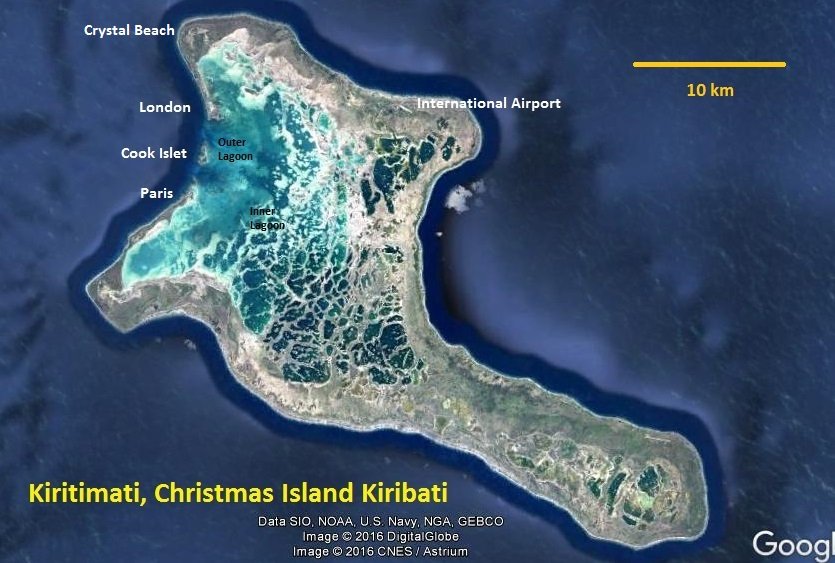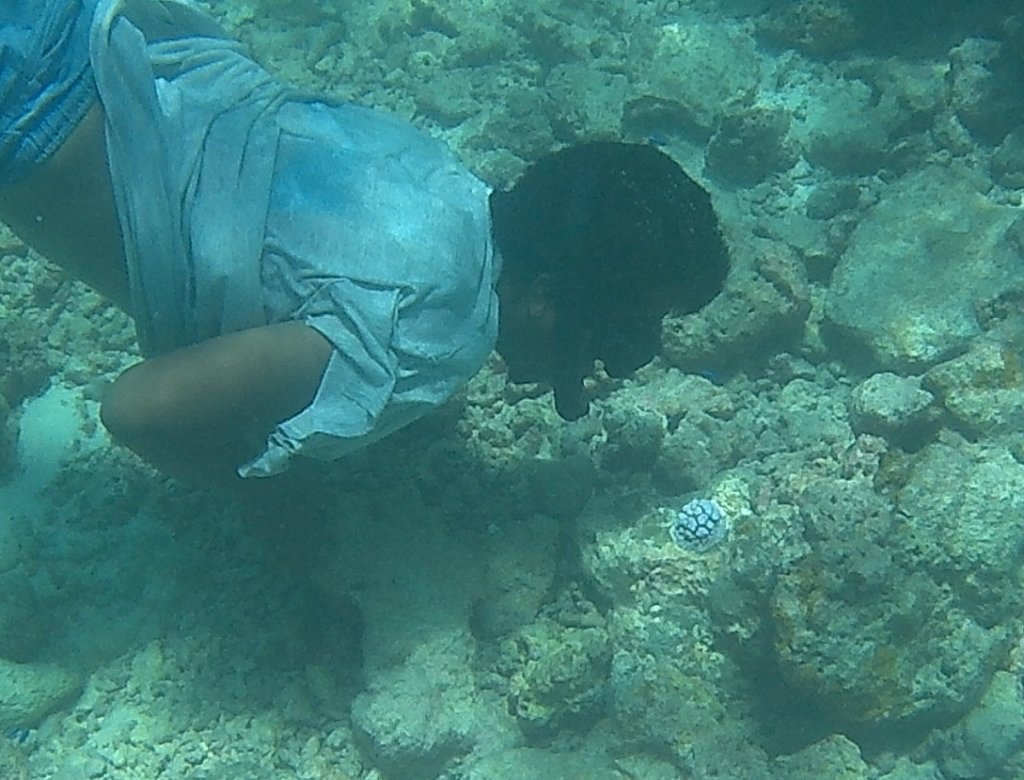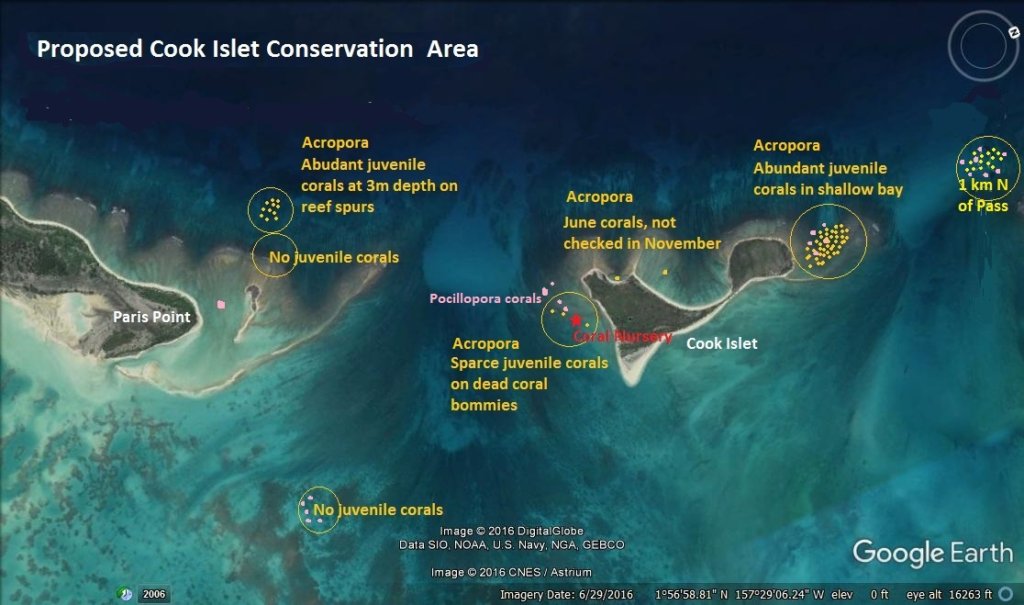By Austin Bowden-Kerby | Project Lead
Christmas Island, Kiribati experienced mass coral bleaching in 2015-16 due to extremely hot waters due to a strong El Nino event super-imposed onto increased temperatures due to climate change. This is the first time in recorded history that a coral reef has experienced such hot water for such long a time. My last report in June, found that >99.9% of all branching corals are dead. This level of coral death due to bleaching is perhaps a first globally for an entire coral reef system. Extensive searching of the lagoon and shallow outer reef slope found expanses of dead corals, with only a few partially alive massive corals remaining, most with only patches of live tissue.The inner lagoon was hit particularly hard, with virtually all corals dying, while the best parts of the outer reef slope and outer lagoon had a maximum 20% survival of the massive corals but no branching corals surviving. Branching corals are the most important for fish habitiat, so the ecosystem has been badly damaged.
In three days of searching with help from the Fisheries department, we eventually did find two branching Acropora corals: one 20cm colony which was a small remnant of a much larger adult colony that had died, and one was a small 5cm juvenile. Four surviving branching Pocillopora colonies were also located. These corals were trimmed and branches brought into a nursery, designed to protect them from coral-killing snails and COTS.
This report focuses on my second visit, which took place 2-9th November 2016. The corals in the nursery were found to be thriving and growing. Other than cleaning some hydroids from the nursery table, the nursery required no maintenance after four months, due to the high numbers of herbivorous fish in the site.
Additional searching for corals was done and we were very excited to find numerous juvenile Acropora corals that were too small to notice in June: three near the coral nursery, 47 in an enclosed reef bay, 11 on the reef slope located in 3 M of water at the top of reef spurs, 14 on the reef crest, and one on the reef flat at Crystal Beach. These 76 juvenile corals represent the beginning of natural recovery and so we are very encouraged. While it is difficult or impossible to assign a species name to the juvenile corals at this stage, many of them are obviously different species, somewhere between 3-7 species. Within a year, the new corals will have grown to the size of grapefruits, and at which point taxonomic identification will be possible, as well as trimming to bring fragments of each into the coral nursey. This is very exciting development, as we should now have more than two genetically unique individuals within many of the branching Acropora species, which is required for successful spawning- to produce coral larvae, which can then settle out to grow into new colonies- in time leading to coral population recovery through natural processes.
But without any adult corals surviving, where did these juvenile corals come from? I believe that they must have come in from Fanning Atoll, which is 300km uncurrent. Their 3-5cm size indicates that the corals are about a year to 18 months old, settling out during the mass bleaching, and acquiring their symbiotic algae, and then somehow surviving the hot water.
The corals are presently too small to move into the nursery, and so unfortunately they are quite vulerable to predators: drupella snails, crown of thorns starfish, and parrotfish, all of which are known to prefer Acropora corals in their diet. While relocating the corals into the protected nursery is important it was not possible. In another six months the corals will become large enough for branches to be trimmed for collection- so a return trip is planned for June, if the funds can be raised. We have hopes that these new corals are bleaching resistant "super corals", and a promnent coral scientist is willing to test samples of the corals for us, to see if they are harbor the bleaching resistant algae or not, so we plan to take small samples for testing next year.
On our next trip, we plan to collect samples of all the new corals, to plant in an expanded coral nursery. This will serve as a gene bank of all the Acropora species surviving the mass bleaching: a “Noaks ark” of bleaching resistant corals for the restoration of the reefs of Kiritimati.
Severe bleaching can be expected to return to Christmas Island in the coming years due to rapidly changing climate and global warming. However, the corals that have survived the last hot water bleaching event can be assumed to be bleaching resistant, offering some hope that adaptation is occurring. We will confirm that, and then replant populations of the bleaching resistant corals, which will then spread into the environment and restore the reefs through natural larval production and recruitment processes. So the next mass bleaching should leave the reefs in a much less damaged position, and with many more unbleached corals.
This work offers some hope that we can help coral reefs survive into the future, in spite of the severe challenges of climate change. Restored and bleaching resistant coral reefs will in turn help secure the ecological, food security, and livelihood services that this precious ecosystem provides to the peoples of Kiribati and the world.
Because this restoration work is so important to the future of the reefs of Kiribati, is very important to set aside the main restoration reefs into a no-fishing marine protected area (MPA), to strictly limit the number of people visiting the sites and placing fishing lines, nets, or stepping on the reefs, as this will break the regenerating corals. We also need a high density of grazing fish to clean the nurseries and the dead corals, so that living corals thrive and so that once coral larvae are generated through spawning of restored coral populations, they can find a clean place to settle out on and grow. With this strategy in mind, the Director of Fisheries took me to meet key people in government: the Ministry of the Line Islands and the local Christmas Island council, both of who were not yet aware that the coral reef had died. I stressed the importance of actions to protect the coral reefs and the importance of fast tracking the establishment of the marine reserve that had formerly been proposed by Fisheries, and where we have placed the coral nursery and where we plan to establish the initial restoration sites.
Christmas Island is a very large Atoll, and millions of corals have perished in the recent mass bleaching event, therefore it will be impossible to replant corals everywhere on the island’s damaged coral reefs. This is not our strategy, rather the “Reefs of Hope” strategy is to help facilitate natural coral recovery process. Firstly we will cultivate as much of the genetic diversity as possible within the nurseries, and then we will use trimmed second generation branches to create genetically diverse patches of spawning corals at intervals along the wider reef, to reseed the reefs naturally with larvae. Certainly more colonies and additional species will be found in time, and pairing those surviving corals with others of the same species will help ensure effective spawning. Our long-term goal is to have the coral nursery eventually expand to include hundreds of distinct genotypes, of each surviving Acropora and Pocillopora species.
The work on Christmas Island goes beyond the simple recovery of this remote atoll’s reefs, rather if we can establish the effectiveness of this program on Christmas Island, it would be vastly relevant to all coral reefs of the planet, facing an uncertain future in a rapidly changing world. What better place to start this pioneering climate change adaptation work?
As the work thus far has been entirely based on volunteerism, what is most important at this time is to identify funding for continuing and expanding this vital and unique program. The work should ideally expand to include more extensive reef surveys on all parts pf the island, to try to identify more of the surviving corals, the monitoring of restoration patches, genetic testing of corals and their symbionts, increased and intensifying nursery work, awareness raising work within the communities, nation, and region, as well as work to secure the no-take status of Cook Islet Conservation Area as a special and sensitive restoration area of critical importance to the larger coral reef system and the nation of Kiribati.
Funding for travel was provided by donations through Global Giving, while boats, fuel, nursery materials, and staff were provided by the Kiribati Fisheries Department, kindly facilitated by Mr. Taratau Kirata, Chief Fisheries Officer. Accommodation was kindly provided by Ereti Tekabwaia through the Tekabwaia lodge.
Coral reefs are the most sensitive ecosystem to climate change and are predicted to be the first ecosystem to collapse due to climate change and the associated increasing temperatures and altered water chemistry. If we can save the coral reefs we can then save the planet, but if the corals go, geological processes and entire economies and societies will also go with them. And then which system will be next? Coral reefs must become the front-line in saving the planet, and where we must now take our stand. Christmas Island in Kiribati has become the leading edge of this battle front.
Thank you so much for yor contined support!
Austin
Project reports on GlobalGiving are posted directly to globalgiving.org by Project Leaders as they are completed, generally every 3-4 months. To protect the integrity of these documents, GlobalGiving does not alter them; therefore you may find some language or formatting issues.
If you donate to this project or have donated to this project, you can receive an email when this project posts a report. You can also subscribe for reports without donating.
Support this important cause by creating a personalized fundraising page.
Start a Fundraiser

